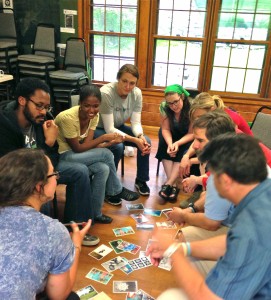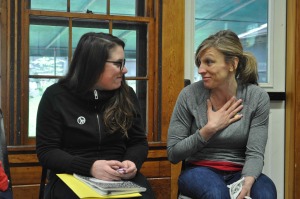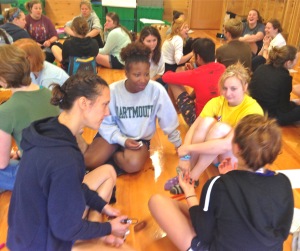Oct 13, 2015 Key Ingredients for Optimal Group Building Experiences
In past articles, I have compared group facilitation to cooking. As in cooking, group facilitation allows for a great deal of room for adaptation, experimentation and adjustment of ingredients to fit different groups and different learning situations.
Though there is opportunity for creativity and innovation, it is important to remember that there are key ingredients from the science of teaching, including educational neuroscience, educational psychology, and social-emotional development research that will help us maximize these learning outcomes with our groups. Here are some of those key ingredients that will help you build a positive and supportive learning environment:
The Experience Starts the Moment Learners Enter the Room (or Even Before) The first few minutes of a group session or class is your opportunity to draw participants into a positive learning experience and increase engagement. Educational psychologists have demonstrated that people tend to remember the most about the first few moments and last few moments of experiences (Sousa, 2006, Willis, 2010). Plan these first few minutes of engagement thoughtfully. What do you want people to remember about their experience? How are you going to welcome them into the learning space? Are administrative duties like release forms the VERY first thing you want the group to remember? There are creative ways you can welcome group members into the meeting space and focus their attention on the tasks at hand. Reflective practice to increase meaning, retention and transfer can begin in these very first moments (see my previous articles on “Strong Beginnings”).
Take Time Up-Front to Build Your Group and Make Thoughtful Activity Choices You will find that time spent at the beginning of your program building relationships, ownership, and reflective skills pay off later in many ways. Think carefully about using appropriate beginning activities that build rapport and trust in incremental ways. It takes time to sequence and build healthy trust within groups. Create the foundation that will allow you to engage learners in more challenging activities, foster more responsibility and control over learning, and increase participant’s ability to move learning forward. When choosing introductory activities, find those that build rapport, camaraderie, connections, shared understanding, and goals in an enjoyable and non-threatening way.
Beware of the Icebreaker Make Thoughtful Activity Choices An icebreaker is meant to “break the ice”— to build respect and a willingness to share that are essential to a productive and supportive learning community. When people are put “on the spot” too early in the group process, however, icebreakers can do the opposite of what was intended. Many people have negative connotations with team-building and icebreakers activities because they have been put in situations where choice and control were taken away.
Although people do learn from challenges there is a fine line between a challenge that helps move learning forward and what the educational philosopher John Dewey (one of the earliest proponents of the philosophy of experiential education) would call a miseducative or potentially damaging experience. Some educators operate with the idea that stress can increase our ability to learn and be creative. There are many icebreakers, games, and initiatives used in group work that are designed to quickly push people out of their comfort zones in order to initiate learning. Unfortunately, some of these activities push people to perform or share information too early or in a threatening and sometimes inappropriate way, leading to some participants “shutting down” or “checking out” of the experience. Though we learn from novelty and from being challenged, it needs to be the right amount of challenge at the right time. Brain research is validating John Dewey’s observation about miseducative experiences by showing that stress can inhibit learning (Willis, 2010). Begin with partner sharing activities with simple questions or an object/picture to use as a talking point.
This gives participants an opportunity to warm up by interacting with just one or two others at a time before sharing with the larger group. Start the group with simpler activities that aren’t overly silly or performance oriented. Include choices about level of participation. By building trust in this way, group members start to share and engage at their own pace and become more willing to push their comfort zones later on when it really matters.
Choice and Control are Essential People learn best when they perceive a sense of control and have choice and ownership over their learning experiences. Think about creating opportunities that build this sense of choice and control from the very beginning of the program. Empowering learners to set reasonable parameters around their participation creates an atmosphere of healthy trust and will increase involvement from reluctant participants.
Learn and Honor Names Knowing and using each other’s names in a respectful way builds trust and positive communication, establishing a supportive group environment. Activities that clarify names can be helpful even to groups that you might think already know each other. A person’s name is important to them and should be honored with correct pronunciation and proper use. Weave name activities and practice into introductory activities, starting with simple partner greetings and sharing before engaging participants in a whole group name activity. Avoid contrived name activities that put people on the spot or require them to feel under pressure to memorize (see previous posts or the Inspired Educator book for ideas to help groups learn and remember names in a palatable way).
Establish and Reflect on Healthy Group Norms Help group members create an environment where they feel responsible for themselves and each other. A supportive atmosphere will allow them to speak up when there is a breakdown in communication or an issue that affects the safety or potential experience of the group. It is ideal when the group takes that responsibility rather than the facilitator or leader. One benefit to using team-building initiatives and play in group development is that the need to make decisions and work out conflict organically arise. Groups have to find ways to figure out how to address these issues in order to go on. When natural conflicts, arguments or negative behaviors arise in the midst of an activity, it can become a teachable moment if facilitated carefully. This is a perfect time to explore meaningful and relevant group norms. Leader imposed ground rules, or expectations should be put forward at the beginning, but participants should be increasingly involved in defining group norms as they move forward and encounter challenging situations together as a group.
Reflection brings learning to life. Intentionally making time for the group to reflect and check in with each other is integral to group process. In this way, experiences can be built upon one another and related to real life and future learning. John Dewey (1933) believed that in order to truly learn from experience, there must be time for reflection. Modern day brain research validates Dewey’s belief that reflection help learners find relevancy and meaning and make connections between their educational experiences and real life situations (Stanchfield, 2014). Reflective practice plays an important part in the development and strengthening of neuronal pathways to enhance retention and the ability to recall and apply lessons. Regular “check-ins” create a forum or opportunity for participants to share what is working, what they need from each other, and for celebrating successes along the way. Reflective practice is best when it is a dynamic, ongoing part of your programs, not just something facilitated at the end of an experience or as a follow-up.
References:
Dewey J. (1933) How We Think, A Restatement of the Relation of Reflective Thinking to the Educative Process. Boston: D.C. Heath and Co.
Stanchfield, Jennifer (2014) The Inspired Educator, The Inspired Learner:Experiential Brain-Based Activities and Strategies to Engage, Motivate, Build Community, and Create Lasting Lessons. Bethany, OK Wood N Barnes Publishing Co.
Stanchfield, Jennifer (2007 Tips & Tools: The Art of Experiential Group Facilitation. Bethany, OK Wood N Barnes Publishing Co.
Willis, J. (2010) The current impact of neuroscience on teaching and learning. In D.A. Sousa Mind, Brain and Education: Neuroscience Implications for the Classroom (pp.44-66). Bloomington, IN: Solution Tree Press.







Mike Cardus
Posted at 16:11h, 13 OctoberThis is a beautiful and thoughtful article. The content shows what makes you one of the greatest in this field. Thank you for your thoughtful and caring approach.